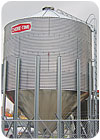HVAC is not exempt from the energy crunch. Efficiency mandates and lower utility bills are just the beginning of environmental and end user demands. To remain competitive, inventive HVAC units are being successfully marketed.
BIOMASS BASICS
Biomass is an integral component of the biofuel equation. It includes all plant and plant-derived material. According to the U.S. Department of Energy (DOE), biomass is essentially all energy originally captured by photosynthesis, making it a fully renewable resource that currently supplies over 3 percent of the United States' total energy consumption.
The Energy Information Administration's "2004 Renewable Energy Trends" report showed that 70 percent of renewable energy was consumed for electricity generation, leaving 30 percent for nonelectrical purposes. It also showed that biomass consumption has increased by 4 percent or 105 trillion Btu in 2004 with wood energy leading the way.

BRING THE HEAT
Many end users have already discovered the benefits of wood energy and wood burning units. There are multiple other emerging biomass technologies, however, that provide indoor comfort. Biofuels such as wheat, grain, sorghum, soybeans, and fruit pits are prime examples. Corn is another popular example of biofuel, and it is beginning to find applications in the HVAC market. The A-Maize-Ing Heat® furnace and boiler, manufactured by LDJ Manufacturing Inc., burns shelled corn as an energy source. According to the company, corn costs less per Btu than other heat sources.The furnace and the boiler come in 100,000 and 165,000 Btu variable rate unit sizes. According to the company, one bushel of corn has as many Btu's as approximately 5 therms of natural gas, 5 gallons of liquid propane, 3.2 gallons of fuel oil, or 131 kilowatt hours of electricity. These numbers are true for both the furnace and the boiler. The units must have a 6-inch round chimney vent with natural draft. It cannot exhaust out a wall. Low stack temperature and the absence of creosote buildup eliminates the possibility of chimney fires.
The systems feed the fuel into the bottom of a 5/8-inch-thick cast iron burn pot. The residual ash then spills over the top of the burn pot into an ash pan effectively creating a self-cleaning combustion chamber.
The units are controlled by a thermostat and will remain lit as long as the bin, which holds 14 bushels of corn, contains fuel. The fuel is automatically fed to the combustion chamber, as needed, by a copper auger. There are differences, but on average, most homes use about 250 bushels per heating season.
The units are manufactured to be stand-alone or to add on to an existing heating system. The furnaces are wired to be ready for a/c. All of the units, both furnace and boiler, are 85 percent efficient and carry a one-year electrical warranty and five-year heat exchanger warranty.
The boiler is a closed system operating at 12-15 psi, and holds 18 gallons of water. Both the boiler and the furnace are UL listed, which is a first, according to LDJ Manufacturing.
"The low cost of shelled corn, together with the efficient burning process of this furnace or boiler, produces an ecologically safe home heating system," said the manufacturer.
CORN GOES TO SCHOOL
Burning corn for fuel is not just for residential applications. Honeywell has embarked on an energy savings and modernization project with Merrill Community Schools in Merrill, Mich. As part of the project, Honeywell will provide energy-efficient infrastructure upgrades, including a corn-burning boiler that will heat the district's middle school by turning bushels of corn into usable energy."This is a first for Michigan schools," said Joe Puishys, president, Honeywell Building Solutions. "The project will also improve school buildings and building systems, increase occupant comfort, and help the district reduce its annual energy costs by an estimated 30 percent."
Merrill Community Schools, serving more than 800 students in Saginaw County, will fund the project with the savings generated by upgrades to its building systems.
With the installation of the corn boiler, Merrill Middle School will become the first Michigan school to use this alternative fuel technology as its main source of heat. The boiler, powered by 7,200 bushels of corn each year, will decrease the district's reliance on fossil fuels and is expected to reduce annual energy costs by $10,000 - a significant increase over the projected $2,000 the district would have saved with a new, traditional boiler.
"Corn's availability, pricing stability, and clean, emission-free burning properties made it especially appealing to us," said John Searles, superintendent of Merrill Community Schools.
Other renewable energy work includes the addition of a waste oil heater in the maintenance building, which will help the district realize more than $2,000 in annual energy savings. The heater will run on waste oil collected from the district bus garage, further decreasing the district's reliance on natural gas.
"With budgets already tight and our natural gas prices up nearly 40 percent, we needed a way to fund upgrades and reduce our energy costs without having to redirect money or turn to tax payers for assistance," said Searles.
"We wanted to make improvements that went beyond the bare minimum and would have a lasting, positive fiscal and environmental impact. This contract allows us to be better stewards of both the environment and tax money."
Publication date: 11/13/2006


Report Abusive Comment